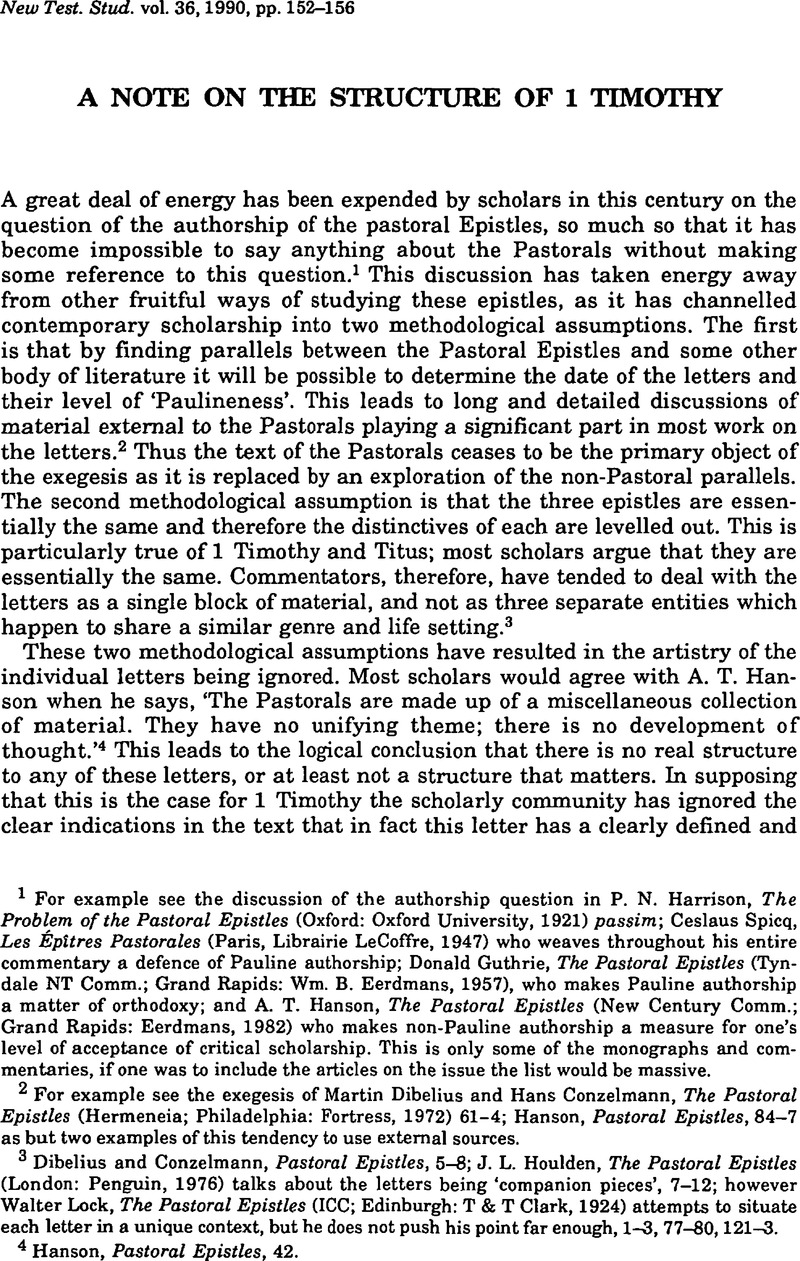Article contents
A Note on the Structure of 1 Timothy
Published online by Cambridge University Press: 05 February 2009
Abstract

- Type
- Short Studies
- Information
- Copyright
- Copyright © Cambridge University Press 1990
References
1 For example see the discussion of the authorship question in Harrison, P. N., The Problem of the Pastoral Epistles (Oxford: Oxford University, 1921) passim;Google ScholarCeslaus Spicq, Les Épîtres Pastorales (Paris, Librairie LeCoffre, 1947) who weaves throughout his entire commentary a defence of Pauline authorship;Google ScholarGuthrie, Donald, The Pastoral Epistles (Tyndale NT Comm.; Grand Rapids: Wm. B. Eerdmans, 1957), who makes Pauline authorship a matter of orthodoxy;Google Scholarand Hanson, A. T., The Pastoral Epistles (New Century Comm.; Grand Rapids: Eerdmans, 1982) who makes non-Pauline authorship a measure for one's level of acceptance of critical scholarship. This is only some of the monographs and commentaries, if one was to include the articles on the issue the list would be massive.Google Scholar
2 For example see the exegesis of Dibelius, Martin and Conzelmann, Hans, The Pastoral Epistles (Hermeneia; Philadelphia: Fortress, 1972) 61–4;Google ScholarHanson, , Pastoral Epistles, 84–7. as but two examples of this tendency to use external sources.Google Scholar
3 Dibelius, and Conzelmann, , Pastoral Epistles, 5–8;Google ScholarHoulden, J. L., The Pastoral Epistles (London: Penguin, 1976) talks about the letters being ‘companion pieces’, 7–12;Google Scholarhowever Lock, Walter, The Pastoral Epistles (ICC; Edinburgh: T & T Clark, 1924) attempts to situate each letter in a unique context, but he does not push his point far enough, 1–3, 77–80, 121–3.Google Scholar
4 Hanson, , Pastoral Epistles, 42.Google Scholar
5 Fee, Gordon D. in his commentary on the Pastoral Epistles suggests a structure for the book of Titus, Fee, 1 and 2 Timothy, Titus (A Good News Comm.; San Francisco: Harper & Row, 1984) 161.Google Scholar
6 Thuren, Jukka, ‘Die Struktur der Schlußlparänese 1 Tim. 6, 3–21’, TZ 26 (1970) 241–53, esp. pp. 242–4. Thuren clearly recognized this parallel but did not provide conclusive evidence for it. As well, he did not push the parallel he saw to its logical conclusion. Unfortunately his work has been virtually ignored.Google Scholar
7 I find Oke's, C. Clare argument (‘A Doxology not to God but Christ’, ExpTim 67 [1955–1956] 367–8) quite weak. As he himself notes, the parallels between 1 Tim 1. 12–16 and 1 Tim 6. 15, 16 are quite striking and seem to militate against the conclusion he presents.Google Scholar
8 It seems clear that a man wrote this letter, a woman would not have written 1 Tim 2. 11–15 and 5. 9–15 in such a harsh manner, if she would have written them at all.Google Scholar
9 Hanson, , Pastoral Epistles, 92;Google ScholarSpicq, , Épitres Pastorales, 146.Google Scholar
10 Thuren, , ‘Die Struktur’, 242–4.Google Scholar
11 For more detail on this issue see: Gundry, Robert, ‘The Form, Meaning and Background of the Hymn quoted in I Timothy 3:16’, Apostolic History and the Gospel (ed. Gasque, W. Ward and Martin, Ralph; Grand Rapids: Win. B. Eerdmans, 1970) 203–22;Google ScholarMurphy-O'Connor, J., ‘Redactional Angels in 1 Tim 3:16’, RB (1984) 178–87;Google Scholarand Bush, Peter G., ‘An Exegetical Study of I Timothy 3:16–4:11’ (unpub. essay, Knox College, University of Toronto, 1988).Google Scholar
- 2
- Cited by




